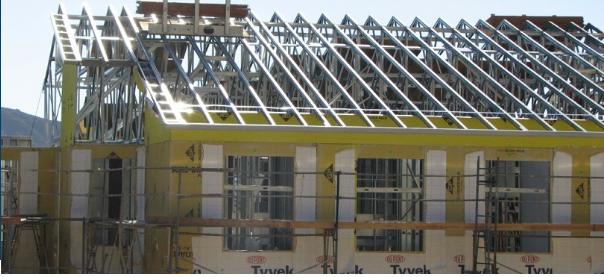Cold-Formed Steel: Beyond Non-Structural Interior Walls

Although some builders may think of cold-formed steel (CFS) as an ideal material for interior framing, that’s not the extent of its utility. CFS delivers many advantages in the construction of wall panels, floor joists, roof trusses, and structural walls as well.
Here are just a few ways CFS can be used beyond interior partition walls.
CFS for Roof Trusses
CFS has wide appeal for roof trusses and cladding because of its fire resistance and durability. For example, designers for the DATCU Corporate Headquarters in Corinth, Texas, originally specified wood trusses for the large mansard, overhanging roof of the office building. When the local building officials informed the project team that they would have to install a sprinkler system to protect the wood-framed trusses, they decided to go with a CFS truss system instead. Avoiding the installation of a sprinkler system saved the company $40,000. According to the project supervisor, Julio Saenz, a four-man crew was able to install the truss system quickly, saving five to six weeks and close to 40 percent on labor expenses.
CFS trusses also weigh less than comparable systems, allowing for lighter foundations, which can contribute to additional cost savings. And, they can provide additional safety benefits, as CFS can resist wind uplift and handle snow loads.
CFS for Panelized Walls
CFS wall panels are easy to install and often require cranes and scaffolding for less time than other systems, which can be a significant financial advantage, especially in tight spaces where the machinery might not easily fit — like urban infill projects.
For the Exempla Saint Joseph Replacement Hospital in Denver, Colorado, prefabricated CFS exterior wall panels were assembled in the factory with greenboard (a type of drywall or gypsum board that is more water resistant than standard drywall) exterior insulation and interior spray-on insulation. The panels were designed with special drainage at the window headers and were built strong enough to carry the weight of the exterior brick façade.
Stephen Bradford, South Valley Drywall project manager, said, “We built everything on a table four feet off the ground. Since we were building in a warehouse out of the elements, our construction was controlled, which allowed us to keep the panels completely square.” Each panel was numbered, trucked to the site and installed using cranes and lifts. According to Bradford, installation of the panels took five months rather than the year it might typically take for a project this size.
Another project, Woodstock Baptist Church in Woodstock, Georgia, faced unique challenges with the 300-foot dome, giant cupola, and 30-foot-tall steel and aluminum cross — which together, weighed 50 tons — that topped the structure. Structural steel was chosen to support the dome, but CFS was selected for the exterior curtain walls (the non-structural outer covering of a building) around the 1,000 square-foot space.
“Cold-formed steel was the only real choice to accommodate the large spans and the expansive curved outer walls,” according to Don Allen, P.E., Super Stud Building Products, who worked on the church while at Starzer Brady Fagan Associates. CFS was an ideal option for this project because of its availability in long lengths, the availability of specialty connectors for thermal, and design flexibility, which allowed for some structural movement. This church went up quickly and at a reasonable cost.
By using prefabricated CFS panels on this project, the components were built in a controlled environment, which allowed for greater quality control. The speed of construction also led to cost savings in carpentry and erection man-hours.
CFS wall covering are available in a variety of types and shapes from embossed to granular and single ply to insulated panels, adding to the architectural appeal and practicality of the material.
CFS for Flooring Joists
Floor joists can be pre-engineered in CFS, which eliminates many of the issues with joists made from other materials, such as moisture absorption, termite damage, and fire risk. In addition, builders often choose CFS joists because they are dimensionally stable and they can eliminate some on-site labor.
For example, the premanufactured joists used in the construction of City Green apartments in Milwaukee, Wisconsin, featured holes large enough to accommodate the HVAC mechanical and plumbing runs.
CFS for Structural Wall Systems
Over the years, CFS has increasingly been replacing other materials as the structural system in a variety of commercial and multi-family applications.
CFS is preferable particularly in hurricane and earthquake-prone locations because it is dimensionally stable, light in weight, and efficient in lateral load resistance. There are two common types of wall systems that provide lateral resistance to a building or structure created with CFS load-bearing stud walls: the CFS light frame strap braced wall system and the sheathed panel shear wall system. Both provide lateral resistance to wind and seismic pressure. These qualities make CFS a superior structural wall framing option.
CFS isn’t just for nonstructural interior walls. These projects demonstrate that CFS is an ideal material for roof trusses, wall panels, and floor joists, as well. Learn more about CFS roof trusses by downloading our eBook, “Cold-Formed Steel Trusses: Design, Performance, and Advantages.”
If you have additional questions about incorporating CFS elements in your next building project, request complimentary support from our team of experts. BuildSteel is a partnership of manufacturers, suppliers, producers and industry organizations offering resources and free project assistance for building professionals.